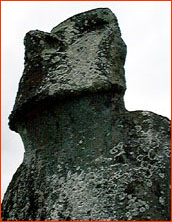
|
 |
 |
 Ahu Akivi
Ahu AkiviAhu Akivi is situated nine miles (15 kilometers) from the quarry. It has been estimated that the moai at this site were probably transported and erected after AD 1400. The replica moai was created from photogrammetric data collected on one statue at Ahu Akivi by Jo Anne Van Tilburg, but is actually represents the statistically average shape, height and weight of 134 statues found intact outside of the quarry where they were carved. Ahu Akivi is an unusual site because it is inland. Although many visitors assume the statues were placed here to face the ocean, in fact they were meant to look out over a very large village which today is in ruins. The site was restored in 1960 by the American archaeologist William Mulloy. During the restoration, it took a full month—using a stone ramp and two wooden levers—to raise the first of the seven moai. By the time they got to the last moai, the same task took them less than a week. 
Ahu Akivi | Ahu Tahai | Ahu Tongariki | Ahu Vinapu | Anakena Beach Orongo | Paro | Hanga Roa | Rano Raraku | Terevaka Photos: Liesl Clark Move a Megalith | Dispatches | Explore the Island | Lost Civilization Resources | E-mail | Table of Contents | Easter Island Home Editor's Picks | Previous Sites | Join Us/E-mail | TV/Web Schedule About NOVA | Teachers | Site Map | Shop | Jobs | Search | To print PBS Online | NOVA Online | WGBH © | Updated November 2000 |